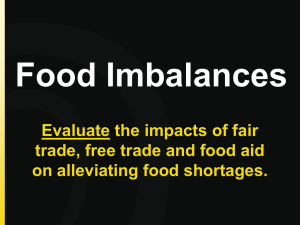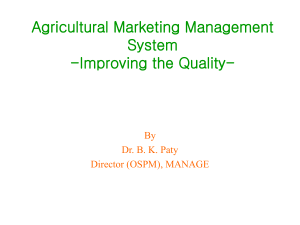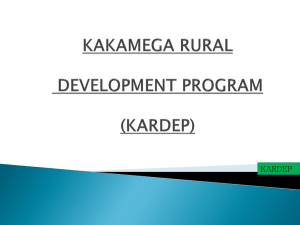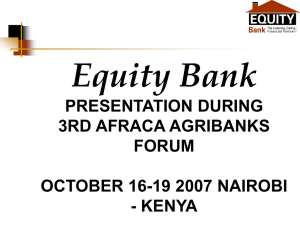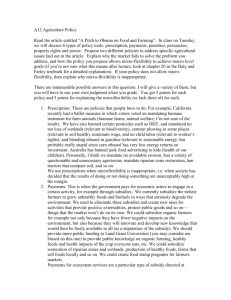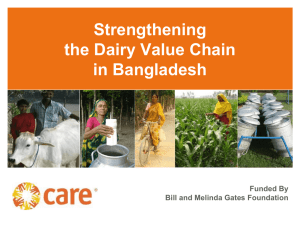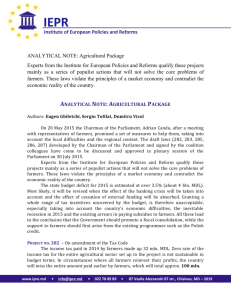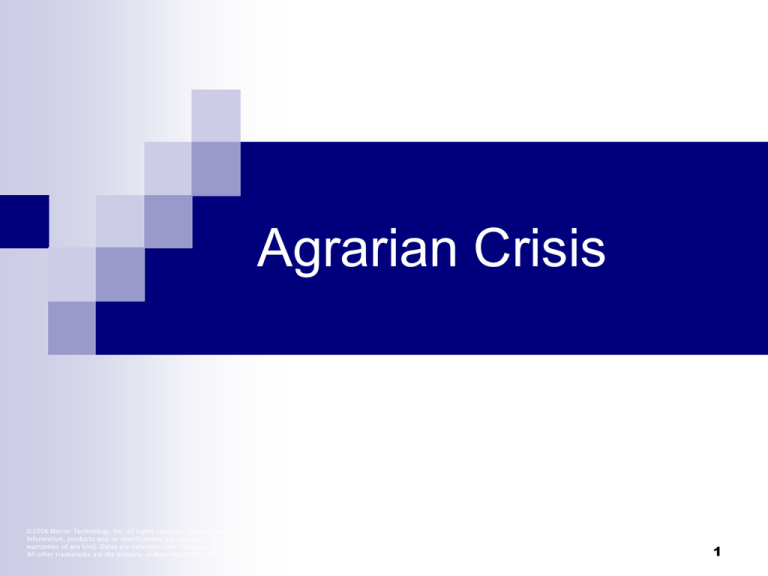
Agrarian Crisis
©2006 Micron Technology, Inc. All rights reserved. Products are warranted only to meet Micron’s production data sheet specifications.
Information, products and/or specifications are subject to change without notice. All information is provided on an “AS IS” basis without
warranties of any kind. Dates are estimates only. Drawings not to scale. Micron and the Micron logo are trademarks of Micron Technology, Inc.
All other trademarks are the property of their respective owners.
1
The problem and symptoms
Farmers in India - being neglected grossly
Unfavorable Government policies cause
distress to the farmers
Symptoms:
FARMER
DEATHS
Widowed women and orphan children
scrambling for survival
2
Alarming Statistics
100,000 farmers have committed suicides in the
last decade
About 1.7 million farmers are under the condition
of distress
75% farmers live on break-even or loss every
year
800 farmers have died in 2007 in the Vidarbha
region alone – 6 districts
Suicides 1 every 6 hours
Less than 50% deaths are officially reported as
deaths due to agrarian distress – women deaths
are not included
3
Root Causes for this condition
Globalization: Falling market prices due to
intense competition
Lack of government protection: government
subsidies are not proportional to the falling
prices for produce
Rain-fed regions: non-sustainable and monsoon
dependent farming result in unpredictable crop
High cost-profit crops: result in huge loss
incurred when crops fail
Government Policy: Land reforms have been
minimal and for the most part useless
4
Current cause of distress
High input costs – cash crop
Low output costs – globalization
Lack of credit – banks refuse loans
Withdrawal of state support – government
does not subsidize and does not forgive
debts
Lack of sustainable agriculture options
5
State of Affairs
Rate of Growth of agriculture:
Less
than ½ it was in 1980
Less than ¼ of our total economic growth
Less than rate of growth of population
Prices/Costs: (1991-2007)
Seeds
rose 300%
Pesticides rose 400%
Output – fell below 60% of price required for
break-even
6
State of Affairs
Banks have provided loans for sowing over the
past years
Farmers are unable to pay of the loans due to
loss of harvest
Bank refuses to give loans anymore
Money lenders and seed and pesticide dealers
became powerful
Government last year allowed more loans to be
issued… this led to more debt and burden on
farmers
7
Government Policy
Promoted green revolution but failed to
take steps to make it sustainable
Did not subsidize input costs incurred and
loan interest rate according to market
adjustment
With pending debts only 30%of the
affected farmers are now eligible for in
loans
8
State of affairs – What
government is doing
Government distributed cows to
beneficiaries of suicide victims
Ironically, the farmers’ widows end-up
spending on the cows’ fodder instead of
getting an income out of it.
The current central government
acknowledges the problem but does not
act upon it
The truth is omni-present
9
Economic growth
or
great divide
??
10
A bigger picture
In the growing economy only 10% of
population is benefited – 90% is
untouched
Big corporations are supported with
numerous subsidies and grants – but the
poor – they practically don’t exist for policy
makers
Only 2% of the policy funds go to
agriculture
11
Economic growth or great divide ??
4000 banks closed between 2001-2004 in
rural India while middle class being wooed
in cities
Loan interests : 14 ½ % for production
related loans to the farmer vs. 4% for a
purchase of new Mercedes Benz to us
SEZ laws take effect in 6 months vs. land
reforms take 60 years
Though economy is growing at the rate of
9% the agriculture growth rate has fell
from 5% to less than 2% in 1 year
12
Economic growth or great divide ??
While Mumbai celebrated the biggest fashion
week in history farmers in Vidarbha we dying 1
every 6 hours
While India ranks 4th in number of $ millionaires
we rank 126th in the human development
Poor people are better off in Botswana or
Palestine than in India !!!
In last 5 years per capita food intake of poor has
gone down by 100kgs
13
AID’s effort
14
Plan of action
Create Awareness – Candle Light Vigil
50
cities and several villages across the world
Send petition to the PM and government
of India demanding immediate attention
and action to help the situation
Pushing for and advocating policy level
reforms in agriculture sector
15



